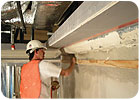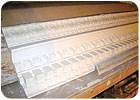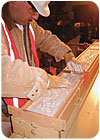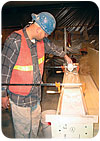
Everyone clamors around the computer business when a new game with enhanced graphics comes out or any hi-tech product shows any sign of advancement, but rarely does the wall and ceiling industry get the credit it deserves for innovation. Don’t believe me? Think about the EIFS industry. Recently, it has had to defend its product akin to something like the tobacco industry defending cigarettes. Robert Thomas wrote a great article last month about unusual and creative uses of EIFS and I could not agree more whole-heartedly. EIFS is an amazing product. Call Hollywood, Las Vegas or Disneyworld and ask for any and all EIFS products to be returned. The ornamentation on these buildings would all but disappear and their future would look pretty grim.
Actually, that may not be totally true. Ornamentation is certainly still possible with real plaster. Look at all the old castles and churches in Europe. They have tons of ornamentation. The wall and ceiling industry today has new products and systems coming out all the time that continue to push the envelope on design and creativity. Architects have a seemingly unlimited source of products to add all types of ornamentation to buildings at a reasonable cost. Ornamentation is still here – it has just changed.

Plasterer applying sanded gypsum plaster to metal lath for a “run” plaster mould. Note the wood running strip attached to wall in preparation for the slipper and template.
ORNAMENTATION
In architecture, ornament is defined as a decorative detail used to embellish parts of a building or interior furnishing. Historical ornament can be carved from stone, wood or precious metals, formed with plaster or clay, or impressed onto a surface as an applied ornament. Ornamentation was and still is taught at the plastering apprenticeship schools around the country. Making plaster casts, motifs, niches, columns, cornices and running molds are all part of the history and romance of real plaster. At one time, ornamental plaster dominated the architectural landscape.Often overlooked is the importance of the proper base or supporting structure for plaster work, the lather. More specifically, cold-rolled lather’s channel, pencil rod and wire-tied expanded metal lath. Just about any shape and size you can imagine can be done with channel, pencil rod and lath. Unfortunately, the labor is today often considered too costly, primarily for two reasons. One, it takes time to do this intricate type of work and labor is expensive. Two, there are not that many trades people out there who can do this type of work. It took quite a few years of apprenticeship and working under the tutelage of a seasoned journeyman to learn this craft. My father and uncle started plastering in the late 1940s and were quite proficient at interior plaster systems. They often said it took an apprentice about six years of daily work on interior plaster to become proficient.

A “cast” mould ready for installation.
HISTORICAL WORK
Most of the trades people capable of forming channels and wire tie or run plaster ornamental molds are working on historical buildings where there are restrictions placed on using modern “simulated” products or systems. Architects should not be afraid to specify real plaster ornamentation. Yes, it is not as popular as it once was, and yes, it will be costly. But no, it is not true that no one can do this work anymore. If an architect has a project that requires or prefers “real” plaster ornamentation, I suggest contacting the plasterers union local in that region of the country. They will have a list of plastering contractors qualified to install ornamental plaster work. The architect can use this list to qualify the contractor and supply the list to the general contractor.Traditional interior ornamental plaster can be categorized into two basic categories: run or cast.

Adding jute fibers to fresh poured casting plaster for strength.
RUN PLASTER 101
Run plaster is the term for plastering in place and is typically done over expanded metal lath. Run plaster will require plasterers to apply several coats of gypsum plaster to attain a specific shape. Run plaster ornamentation is popular for cornices and moldings. The term “run” is used to describe the process of using a cutout shape of wood and metal as a screed or template. Many plasterers will use wood, then cover the wood template with sheet metal. The wood is easily shaped and the metal provides a durable, slicker surface for running or cutting molds. The basic idea is to add plaster, usually with a hawk and trowel, then run the cutout template shape to form or run the shape. In complicated or large cornice work, it is possible to use more than one template. It is not uncommon to have a “rough” template and a “finish” template. The template is attached to a slipper, a flat piece of wood that holds the template at a particular angle and slides along the running strip that is temporarily attached to the wall.The first coat is typically a sanded gypsum plaster over the metal shape to provide a base for the casting or molding plaster. The succeeding coats are typically a molding gypsum plaster. This plaster is essentially a plaster-of-Paris with additives to make them more workable and control set times to run molds or cornices. There are specific products that have extra high strength for very thin wall ornamental plaster work.
Running molds can be tedious work and requires skill, patience, a good eye and steady hand. Once the shape (profile) is basically formed with the plaster, the mix ratios change to suit the plasterer and achieve a smooth finished product. The only way to know how to do this is to actually do it under the tutelage of a seasoned professional. Plasterers will use a series of tools and materials to make unforeseen conditions work. It is truly a case where art, materials science and trade knowledge all come together.

Pouring plaster into a casting mould.
CAST PLASTER 101
There are occasions where running plaster in place is not practical or desired. In these cases, casting is another possible method. This method was popular for very ornate floral and other artwork that did not follow straight lines. Silicone rubber cast molds are made to achieve or copy a desired look. This may be to match existing in-place work or to create new designs. Today, most cast plaster work is done to match existing work from decades ago. A rubber mold is made over an existing section of plaster you wish to re-create. The rubber mold is allowed to harden and then used similar to a cake mold. An enriched casting plaster is poured into the mold. The plaster may be reinforced with wood fiber, fiberglass strands or a mesh to add strength and resist cracking. It is also common on heavy pieces to use burlap, wire or mechanical fasteners to aid in the attachment to walls or ceilings.The plaster hardens and then is removed from the molds. Then, castings are attached to the walls and/or ceilings with casting plaster as a glue. Test samples for proper bonding are always recommended. Additional mechanical fasteners may be needed for heavier pieces. On the state Capitol building in Olympia, Wash., the plasterers in the 1930s used strips of burlap soaked in gypsum plaster to tie the castings to the structure. The wet burlap strips allowed the flexibility for installation and then became rigid after they were set in place. While the system seems archaic and questionable, it has survived two significant earthquakes intact.
The castings are made in lengths that are reasonable for trades people to handle and install. The joints were typically covered with burlap or jute and casting plaster. Today, fiberglass mesh can be used. A light sanding and the ornamental plaster is ready for a finish coat of thin plaster if needed and then painted.
It is possible and common to “run” basic plaster shapes, then use cast plaster molds for the more ornate detail work over the run plaster. The basic shapes are run in place with templates, slippers and running strips and then allowed to set. In the meantime, the castings that will be applied over the run shapes are being done off site or at an on-site shop, which are more practical for projects with multiple designs that have to be constantly compared to in place originals and quick fixes.
ORNAMENTATION TODAY
Most ornamentation today will not be done by hand with lath and casting plaster. Glass Fiber Reinforced Gypsum (GFRG) or Glass Fiber Reinforced Concrete (GFRC) are much more common and economical to make columns, brackets, reliefs, domes, medallions and moldings. One question often asked is which should I use, GFRC or GFRG? Generally, gypsum is an interior product and should be limited to areas not subjected to high humidity. Concrete, like portland cement, is not affected by moisture and can be used in any location. The advantage to GFRG is the weight and the fact that patching in the seams or joints tends to be easier with gypsum. Another strong advantage to both GFRG and GFRC systems are the weight reductions compared to the stone or plaster products. The creation of alkaline-resistant fibers in 1967 allowed GFRC to really take off.Much of the new ornamentation for decorative interior molding is made from EPS (Expanded Poly Styrene) foam and then covered with a thin coating of modified setting gypsum plaster. These products come in a wide variety of shapes and sizes. They are lightweight, easily cut to size and can be adhesively applied to gypsum wallboard surfaces. It is recommended to use standard “heavyweight” joint compounds for better adhesion rather than the more popular lightweight joint compounds used for joint treatment. Never use topping compounds to adhere decorative shapes to substrates. Test all products used to adhere foam shapes; some adhesives will melt or dissolve the foam backing.
FUTURE
The EIFS industry and others have taken the lighter version of these products to new levels. They are amazingly strong for being so lightweight. If you are thinking that you have seen these products and they are not that new, I agree. The primary difference today is the realism of these products. In the past, they looked real only from across the street – way across the street. Today, you can touch them and may have to ask yourself, “Is it real?”When using these products, think abuse and suitability. For example, high schools in inner cities may not be the best location for foam shapes or very thin products. I would recommend these products only where abuse resistance is not a concern. The abuse requirement may limit some design details or options. For the most part, it’s amazing what these products can create. This is why Las Vegas and Disneyworld are great examples of what can be done with all of these products on the interior and exterior. Where else can you create a European structure complete with all the ornamentation at a fraction of the cost?
So, my hat is off to the wall and ceiling industry for what you have created. I cannot wait to see what you have in store for the future!


Report Abusive Comment